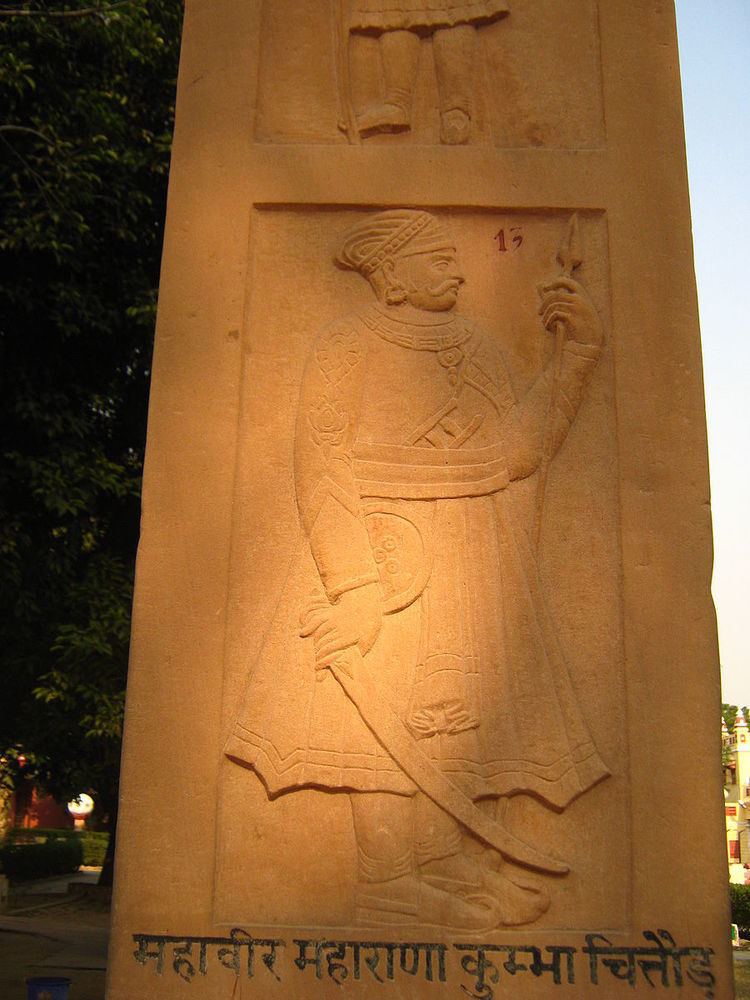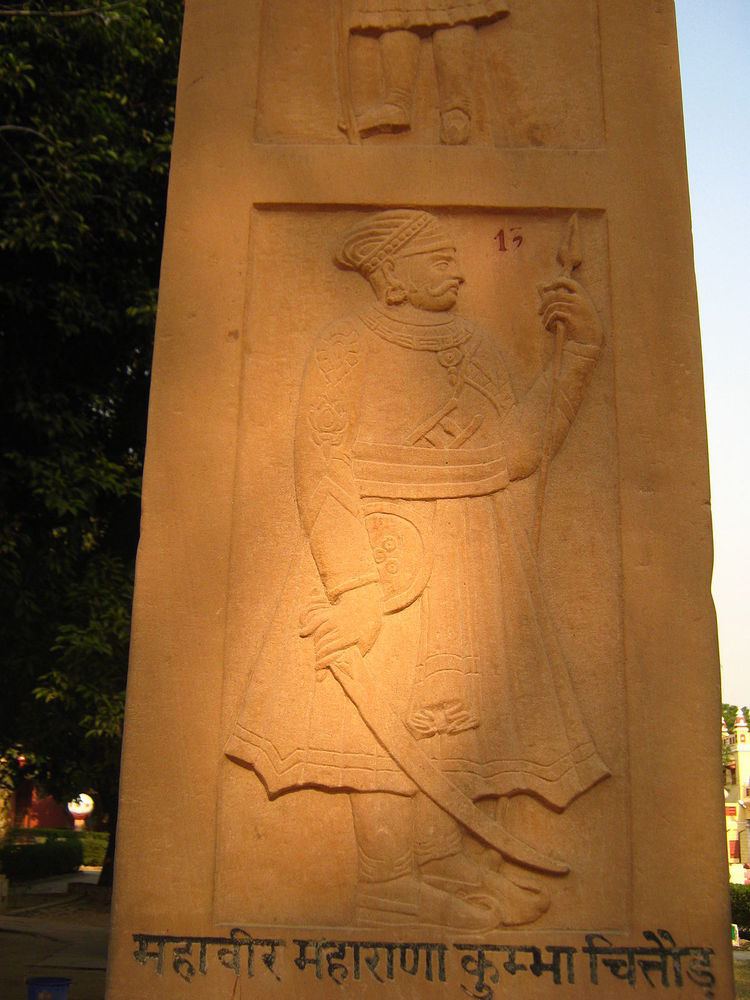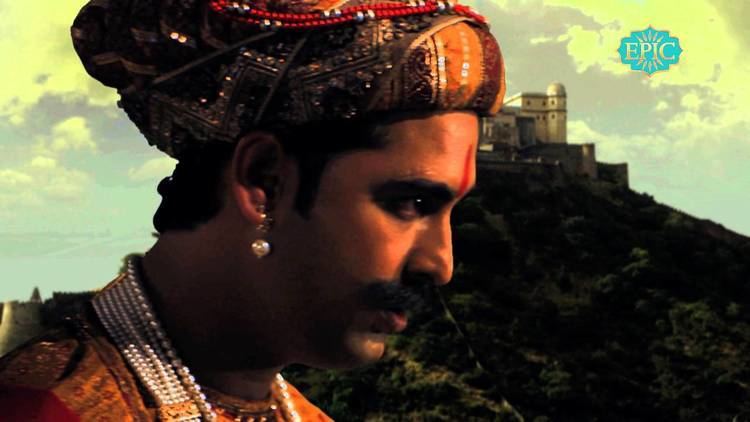Reign 1433-68 (35 years) Mother Sobhagya Devi | Died 1468 Predecessor Rana Mokal Name Kumbha Mewar | |
 | ||
Parents Sobhagya Devi, Mokal of Mewar Great grandchildren Udai Singh II, Bhoj Raj, Vikramaditya Singh, Ratan Singh II | ||
Children Rana Raimal, Udai Singh I Grandparents Hansa Bai, Lakha Singh | ||
Maharana kumbha of mewar in hindi
Kumbhakarna (r. 1433-1468 CE), popularly known as Rana Kumbha in vernacular legends, was the ruler of Mewar kingdom of western India. He belonged to the Sisodia clan of Rajputs. Kumbha was a son of Rana Mokal Singh of Mewar by his wife Sobhagya Devi, a daughter of Jaitmal Sankhla, the Paramara fief-holder of Runkot in the state of Marwar.
Contents
- Maharana kumbha of mewar in hindi
- Early period
- The middle period
- Capture of Nagaur and reaction of the sultans
- Construction of forts
- Cultural achievements
- Vijay Stambha
- Architecture
- Death of Rana Kumbha and aftermath
- References

Early period

After being overrun by the armies of Alauddin Khilji at the turn of the 13th century, Mewar had become relatively insignificant. Rana Hammira is credited with casting off the Muslim yoke and establishing the second Guhila dynasty of Chittor in 1335. The title Rana and later Maharana was used by rulers of this dynasty.
Rana Hammira's grandson, Maharana Mokal was assassinated by two brothers (Chacha and Mera) in 1433. Lack of support, however, caused Chacha and Mera to flee and Rana Kumbha ascended the throne of Mewar. Initially, Rana Kumbha was ably assisted by Ranmal (Ranamalla) Rathore of Mandore. In November 1442, Mahmud Khilji, Sultan of Malwa, commenced a series of attacks on Mewar. After capturing Machhindargarh, Pangarh and Chaumuha, the Sultan camped for the rainy season.
On April 26, 1443, Rana Kumbha attacked the Sultan's encampment, following an indecisive battle the Sultan returned to Mandu. The Sultan attacked again in November 1443, capturing Gagraun and adjoining forts but the capture of Chittor eluded him. The sultan then fought and lost in the Battle of Mandalgarh and Banas. Bloodied by these engagements, the Sultan did not attack Mewar for another ten years. In order to commemorate his resounding victory over the combined armies of Malwa and Gujarat in 1440 AD, Rana Kumbha got the famed 37 meter, 9 storey high Vijay Stambha erected at Chittorgarh which was completed in 1448 CE.
The middle period
Ahmad Shah (ruler of Gujarat), and Muhammad Shah (ruler of Delhi) cooperated with Rana Kumbha to combat Mahmud Khalji. During this period, the rulers of Delhi and Gujarat conferred on Rana Kumbha the title of Hindu-suratrana ( Hindu Sultan ). Rana Kumbha was the first Hindu ruler to be given this accolade by the Muslim Sultans.
Capture of Nagaur and reaction of the sultans
The ruler of Nagaur, Firuz (Firoz) Khan died around 1453-1454. This set into motion a series of events which tested Kumbha's mettle as a warrior. Shams Khan (the son of Firuz Khan) initially sought the help of Rana Kumbha against his uncle Mujahid Khan, who had occupied the throne. After becoming the ruler, Shams Khan, refused to weaken his defenses, and sought the help of Qutbuddin, the Sultan of Gujarat (Ahmad Shah died in 1442). Angered by this, Kumbha captured Nagaur in 1456, and also Kasili, Khandela and Sakambhari.
In reaction to this, Qutbuddin captured Sirohi and attacked Kumbhalmer. Mahmud Khilji and Qutbuddin then reached an agreement (treaty of Champaner) to attack Mewar and divide the spoils. Qutbuddin captured Abu, was unable to capture Kumbhalmer, and his advance towards Chittor was also blocked. Rana Kumbha allowed the army to approach Nagaur, when he came out, and after a severe engagement, inflicted a crushing defeat on the Gujarat army, annihilating it. Only remnants of it reached Ahmedabad, to carry the news of the disaster to the Sultan.
Mahmud Khilji captured Ajmer and in December 1456, conquered Mandalgarh. Taking advantage of Kumbha's preoccupation, Rao Jodha (the son of Ranmal Rathore) captured Mandore. It is a tribute to Rana Kumbha's skills that he was able to defend his kingdom against this multi-directional attack. The death of Qutbuddin Ahmad Shah II in 1458, and hostilities between Mahmud Begada (the new ruler of Gujarat) and Mahmud Khilji allowed Rana Kumbha to recapture his lost territories.
Rana Kumbha successfully defended Mewar and expanded his territory at a time when he was surrounded by enemies like Mahmud Khilji of Malwa, Qutbuddin Ahmad Shah II of Gujarat Sultanate, Shams Khan of Nagaur and Rao Jodha of Marwar.
Construction of forts
Kumbha is credited with having worked assiduously to build up the state again. Of 84 fortresses that form the defense of Mewar, 32 were erected by Kumbha. Inferior only to Chittor, the chief citadel of Mewar, is the fort of Kumbhalgarh, built by Kumbha. It is the highest fort in Rajasthan (MRL 1075m). The building of Kumbalgarh was a great change done in the ancient rules of Vastu Shashtra.
Cultural achievements
Amongst Rajput rulers, the flowering of arts and culture during Kumbha's reign is exceeded only by Bhoja Paramara (Bhoja I). Maharana Kumbha is credited with writing the Samgita-raja, the Rasika-priya commentary on the Gitagovinda, the Sudaprabandha, and the Kamaraja-ratisara. No copies of the Sangita-ratnakara and Sangita-krama-dipaka (two books on music by Rana Kumbha) have survived. During Rana Kumbha's reign, the scholar Atri and his son Mahesa wrote the prashasti (edict) of the Chittor Kirti-stambha and Kahana Vyasa wrote the Ekalinga-mahamatya.
Vijay Stambha
Rana Kumbha commissioned the construction of an imposing, 37 meter high, 9 story Victory Tower at Chittor. The tower called Vijay Stambha (Victory Tower) was completed in 1458. It is also referred to as Vishnu Stambha - "Tower of Vishnu" in other texts. The tower is covered with exquisite sculptures of Hindu Gods and Goddesses and depicts episodes from the Ramayana and the Mahabharata.
There are many inscriptions on the Stambha from the time of Maharana Kumbha.
Architecture
In addition to the Vijay Stambha of Chittor, the Ranakpur Trailokya-dipaka Jain temple with its adornments, the Kumbhasvami and Adivarsha temples of Chittor and the Shantinatha Jain temple are some (of many) structures built during Rana Kumbha's rule. Maharana Kumbha Create in his life 32 Ghar in rajasthan
Death of Rana Kumbha and aftermath
In a patricide, Rana Kumbha was killed by his son Udaysimha (Udai Singh I). His achievements, however, continue to inspire successive generations of Indians.
Udai Singh I did not live long and was killed by a lightning strike in Delhi after he went to offer his daughter in marriage to the Delhi Sultan. In five years of his reign, he lost much of Mewar territory and made Abu Deora Chief independent and gave Ajmer, Sakambhari to Marwar's Rathore king Jodha as a token of friendship(they were cousins). Udai Singh was succeeded not by his son but another brother, Raimal of Mewar. Raimal sought help of Sultan of Delhi and a battle ensued at Ghasa in which Sahasmall and Surajmall, the rebel brothers were defeated by Prithviraj, second son of Raimal.
However, Prithviraj could not ascend the throne immediately because Raimal was still alive. Nevertheless, he was chosen as the crown prince, as his younger brother Jaimal was killed earlier, and his elder brother Sangram Singh was absconding since the fight between the three brothers.
Prithviraj was ultimately poisoned and killed by his brother-in-law, whom Prithviraj had beaten up for maltreating his sister. Raimal died of grief a few days later, thus paving way for Sangram Singh to occupy the throne. Sangram Singh, who had, meanwhile, returned from self-exile, ascended the throne of Mewar and became famous as Rana Sanga.
